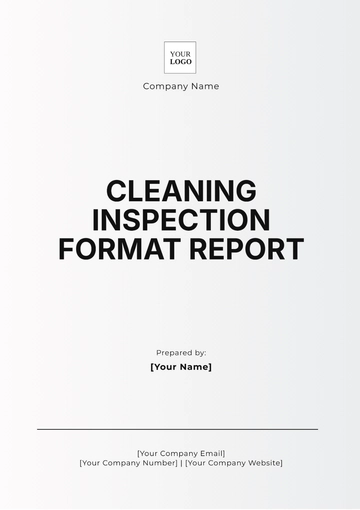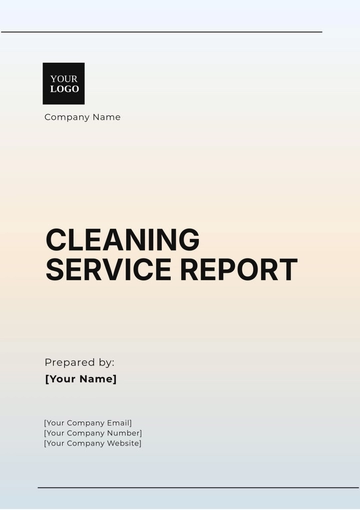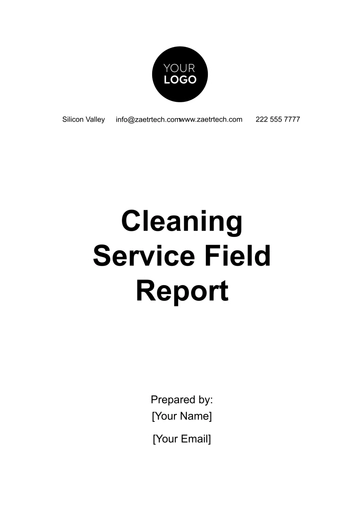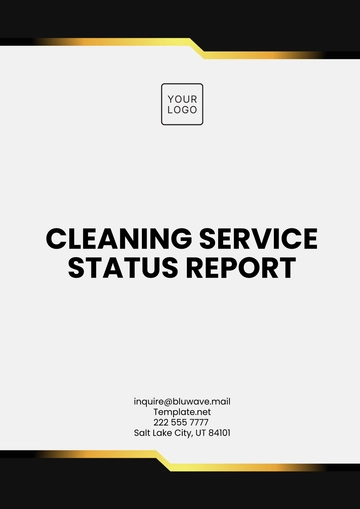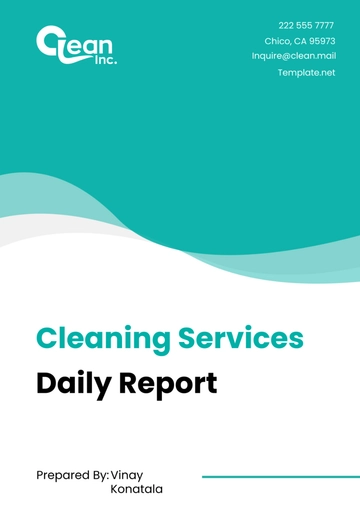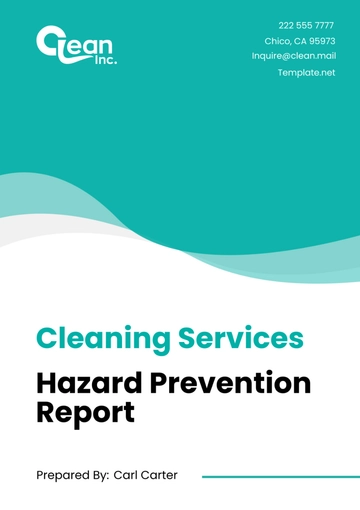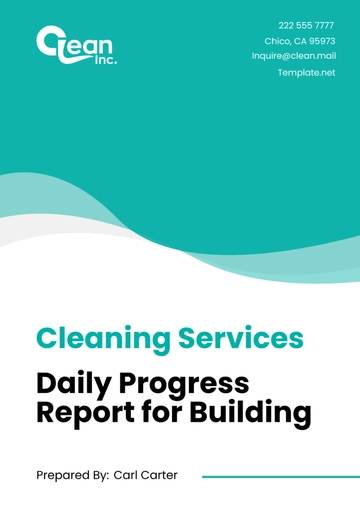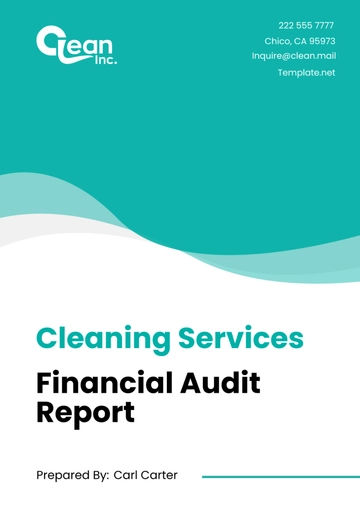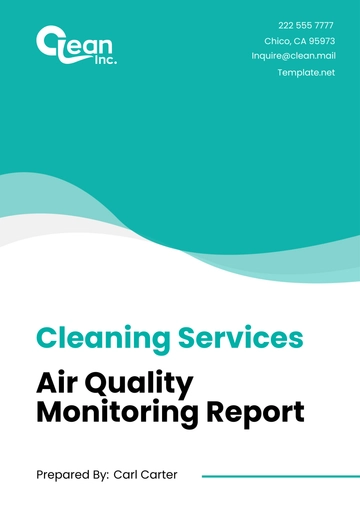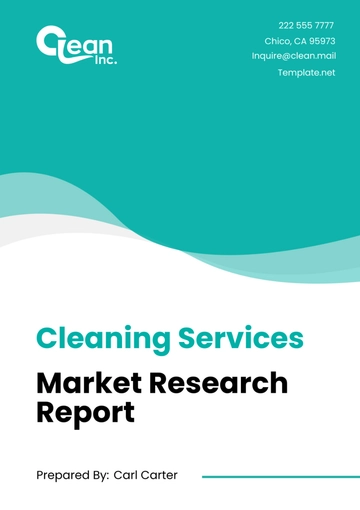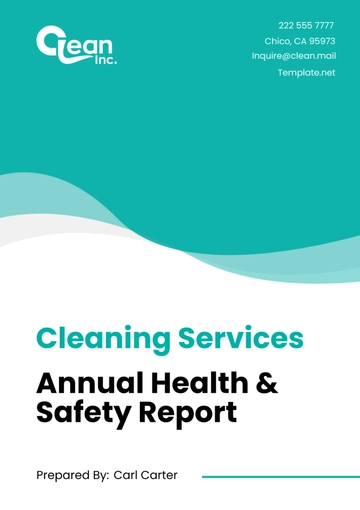Free Cleaning Services Financial Audit Report
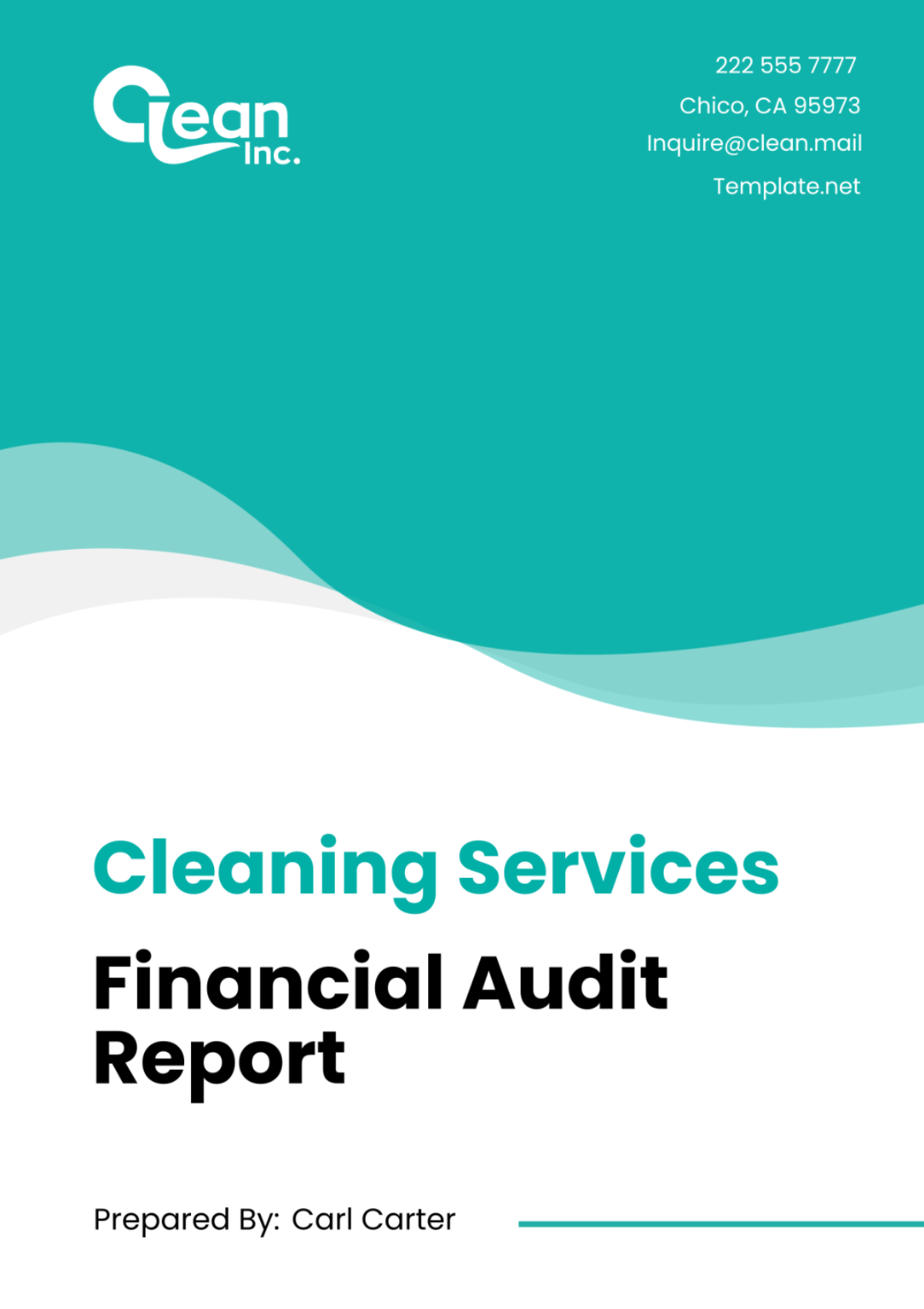
A. Executive Summary
This Financial Audit Report presents a comprehensive review of the cleaning services financial operations of [Your Company Name] for the fiscal year ending [Month, Day, Year]. The audit was conducted to assess the accuracy of financial statements, the effectiveness of internal controls, compliance with applicable tax laws, and to identify areas for financial and operational improvement.
Key Findings:
Revenue Recognition: Revenue streams were accurately reported, with minor discrepancies found in the timing of revenue recognition for long-term contracts.
Expense Reporting: Expenses were generally categorized and reported correctly. However, discrepancies were noted in the allocation of certain indirect expenses.
Internal Controls: The company has implemented a range of internal controls, but weaknesses were identified in controls over cash handling and inventory management.
Tax Compliance: [Your Company Name] is largely compliant with tax obligations. However, potential improvements in tax strategy could result in savings.
Recommendations are provided to address these findings, with a focus on enhancing financial accuracy, strengthening internal controls, and optimizing tax strategies.
B. Introduction
Purpose of the Audit
The purpose of this financial audit was to independently verify the accuracy of [Your Company Name]'s financial statements, assess the company's compliance with regulatory requirements, evaluate the effectiveness of internal controls, and provide actionable recommendations for improvement.
Scope of the Audit
The audit covered all primary financial operations, including revenue, expenses, payroll, asset management, and tax compliance. Areas not covered in this audit include in-depth evaluation of long-term financial planning and investment strategies.
Audit Methodology
The audit was conducted through a combination of document review, interviews with key personnel, direct observation of operations, and sampling of financial transactions. The methodology was designed to provide reasonable assurance about the accuracy of the financial statements and the effectiveness of financial controls.
Statement of Compliance
The audit that was carried out was conducted while stringently adhering to the Generally Accepted Auditing Standards, also known as GAAS. Additionally, this audit follows very closely and unfolds strictly according to the principles of both independence and objectivity.
C. Financial Statements Overview
Balance Sheet as of [Month, Day, Year]
Assets | [Year] | [Year] |
|---|---|---|
Cash and Cash Equivalents | $50,000 | $30,000 |
Accounts Receivable | $100,000 | $90,000 |
Inventory | $20,000 | $25,000 |
Property, Plant, and Equipment (net) | $200,000 | $190,000 |
Total Assets | $370,000 | $335,000 |
Liabilities and Equity | [Year] | [Year] |
|---|---|---|
Accounts Payable | $40,000 | $35,000 |
Long-term Debt | $100,000 | $120,000 |
Total Liabilities | $140,000 | $155,000 |
Shareholders' Equity | $230,000 | $180,000 |
Total Liabilities and Equity | $370,000 | $335,000 |
Analysis:
Assets increased by $35,000, driven by increases in cash, accounts receivable, and property, plant, and equipment, offset by a decrease in inventory.
Liabilities decreased by $15,000 due to a reduction in long-term debt, improving the company's debt-to-equity ratio.
Shareholders' equity increased by $50,000, reflecting retained earnings and potentially new equity investments.
Income Statement for the Year Ended [Month, Day, Year]
Revenue and Expenses | [Year] | [Year] |
|---|---|---|
Revenue | $300,000 | $270,000 |
Cost of Goods Sold | $150,000 | $140,000 |
Gross Profit | $150,000 | $130,000 |
Operating Expenses | $70,000 | $65,000 |
Operating Income | $80,000 | $65,000 |
Interest Expense | $5,000 | $6,000 |
Net Income Before Taxes | $75,000 | $59,000 |
Taxes (20%) | $15,000 | $11,800 |
Net Income | $60,000 | $47,200 |
Analysis:
Revenue increased by $30,000 (11.1%) due to expanded services and increased customer base.
Gross Profit saw a significant increase, primarily due to better cost management in Cost of Goods Sold.
Operating Income increased, reflecting effective control over operating expenses and improved operational efficiency.
Net Income grew by $12,800, benefitting from higher revenues and controlled costs, along with reduced interest expenses.
Cash Flow Statement for the Year Ended [Month, Day, Year]
Cash Flows | [Year] |
|---|---|
Operating Activities | |
Net Income | $60,000 |
Adjustments to reconcile net income | $10,000 |
Changes in working capital | ($5,000) |
Net Cash Provided by Operating | $65,000 |
Investing Activities | |
Purchase of Equipment | ($30,000) |
Net Cash Used in Investing | ($30,000) |
Financing Activities | |
Repayment of Debt | ($20,000) |
Net Cash Used in Financing | ($20,000) |
Net Increase in Cash | $15,000 |
Cash at Beginning of Period | $30,000 |
Cash at End of Period | $50,000 |
Analysis:
The company generated $65,000 from operating activities, indicating healthy operational efficiency.
Cash spent on investing activities ($30,000) was primarily for the purchase of new equipment, suggesting reinvestment in the business for growth.
Financing activities used $20,000 of cash, mainly for debt repayment.
D. Detailed Audit Findings
Revenue Verification
Methodology for Verifying Revenue
A random sampling of revenue transactions was selected for verification. This included contracts, invoices, and receipts. The timing of revenue recognition was also reviewed to ensure compliance with Generally Accepted Accounting Principles (GAAP).
Findings and Observations
Revenue was accurately reported, with a 99% match between reported figures and verified transactions. Minor discrepancies were related to the timing of revenue recognition for some long-term contracts, which did not materially affect the financial statements.
Recommendations
Review and adjust revenue recognition policies for long-term contracts to ensure compliance with GAAP.
Implement regular training for accounting staff on revenue recognition standards.
Expense Analysis
Methodology for Verifying Expenses
Expenses were verified through a review of invoices, receipts, and bank statements. Expense categories were examined for appropriateness, and a sample of transactions was tested for accuracy and compliance with company policies.
Findings and Observations
Expenses were generally categorized and reported correctly. Discrepancies were noted in the allocation of certain indirect expenses, leading to minor inaccuracies in cost center reporting.
Recommendations
Conduct a thorough review of expense categorization, focusing on the correct allocation of indirect expenses.
Implement more detailed guidelines for expense reporting and categorization.
Payroll and Benefits Verification
Methodology for Verifying Payroll and Benefits
The audit team conducted a detailed review of payroll records, including pay rates, hours worked, and payroll taxes. Benefits expenses such as health insurance, retirement contributions, and other employee benefits were also examined for compliance with company policies and regulatory requirements.
Findings and Observations
Payroll Accuracy: The payroll system accurately calculates pay based on hours worked and pay rates. No significant discrepancies were found in payroll taxes.
Benefits Administration: Benefits expenses are generally in line with company policies. However, a lack of formalized procedures for regular review of benefit providers was noted, potentially leading to higher costs.
Recommendations
Implement formal procedures for the regular review and competitive bidding of benefit providers to ensure cost-effectiveness.
Strengthen documentation and review processes for payroll changes to maintain accuracy and compliance.
Asset Management
Methodology for Verifying Assets
Asset verification involved physical inspection of major assets and review of asset records, including acquisition dates, depreciation schedules, and disposal records for fixed assets. Inventory counts were also conducted to verify accuracy against records.
Findings and Observations
Fixed Assets: Fixed assets were well-documented and physical verification matched the records. However, discrepancies in depreciation calculations were noted for a small number of assets.
Inventory Management: The inventory system is effective in tracking stock levels. Minor discrepancies were found between physical counts and inventory records, suggesting occasional lapses in inventory control.
Recommendations
Review and correct depreciation schedules for assets with identified discrepancies.
Enhance inventory control procedures, including more frequent counts and improved reconciliation processes.
Liability Assessment
Methodology for Verifying Liabilities
The verification of liabilities included a review of accounts payable records, loan agreements, and other debt obligations. Compliance with the terms of debt agreements was also assessed, including interest rates, repayment terms, and covenants.
Findings and Observations
Accounts Payable: Accounts payable records are accurate, and payments are made in a timely manner, ensuring good standing with suppliers.
Debt Management: The company is in compliance with all terms of debt agreements. However, an opportunity to refinance existing debt at lower interest rates could reduce financial charges.
Recommendations
Continue to maintain timely payment practices to preserve supplier relationships and credit standing.
Explore opportunities to refinance existing debt to take advantage of lower interest rates and reduce financial costs.
E. Internal Controls and Procedures
Overview of Existing Controls
[Your Company Name] has established a set of internal controls designed to ensure the accuracy of financial reporting, safeguard assets, and facilitate compliance with applicable laws and regulations. These controls encompass authorization processes, physical and digital security measures, periodic reconciliations, and independent reviews. Notably, the company utilizes a centralized accounting system to monitor financial transactions and employs segregation of duties to mitigate the risk of errors or fraud.
Effectiveness of Internal Controls
The audit team's assessment revealed that the company's internal controls are generally effective in maintaining the integrity of financial reporting and operations. Key controls, such as the authorization of transactions and the reconciliation of financial records, are properly designed and operating effectively. However, areas for improvement were identified in cash handling and inventory management, where existing controls do not fully mitigate the risk of misappropriation.
Recommendations for Improvement
To enhance the effectiveness of internal controls, [Your Company Name] should consider the following actions:
Strengthen Cash Handling Procedures: Implement more rigorous controls around cash receipts and disbursements. This could include the use of lockboxes, more frequent bank deposits, and dual authorization for cash payments.
Improve Inventory Management: Adopt tighter controls over inventory, including regular, unscheduled inventory counts and the use of an inventory management system to track movements and discrepancies in real time.
Enhance Training Programs: Develop and implement ongoing training for employees on internal control procedures and the importance of compliance to ensure that all team members understand their roles and responsibilities.
F. Compliance with Legal and Regulatory Requirements
Compliance Overview
The audit evaluated [Your Company Name]'s compliance with key legal and regulatory requirements relevant to the cleaning services industry. This included labor laws, health and safety regulations, environmental standards, and tax compliance. Overall, the company demonstrates a strong commitment to compliance, with comprehensive policies and procedures in place to meet legal obligations.
Recommendations for Ensuring Compliance
To further strengthen compliance and mitigate risks associated with regulatory requirements, [Your Company Name] should:
Enhance Documentation Practices: Ensure thorough and timely documentation of all compliance-related training sessions, especially for health and safety protocols. This includes maintaining records of attendance and topics covered.
Regular Compliance Reviews: Implement a schedule for regular, comprehensive reviews of compliance with all applicable laws and regulations. These reviews should be conducted at least annually and involve updates to policies and procedures as needed.
Engage External Experts: Consider consulting with legal and regulatory experts specializing in the cleaning services industry to stay abreast of changes in laws and regulations and to receive guidance on complex compliance matters.
G. Recommendations and Action Plan
To address the findings of this audit, [Your Company Name] should consider the following action plan:
Plan | Details |
|---|---|
Revenue Recognition Adjustment | Timeline: Q2 [Year] Action: Review and adjust revenue recognition policies to ensure full compliance with GAAP. Train staff accordingly. |
Expense Reporting Improvement | Timeline: Q3 [Year] Action: Revise expense categorization guidelines and conduct training sessions for relevant staff to ensure accurate reporting. |
Strengthen Internal Controls | Timeline: Q3 [Year] Action: Implement stronger controls over cash handling and inventory management, including periodic audits and staff training. |
Optimize Tax Strategy | Timeline: Q4 [Year] Action: Conduct a comprehensive review of current tax strategies, focusing on identifying and utilizing all available tax credits and deductions. Engage a tax consultant to explore the potential benefits of restructuring the business entity if applicable. |
- 100% Customizable, free editor
- Access 1 Million+ Templates, photo’s & graphics
- Download or share as a template
- Click and replace photos, graphics, text, backgrounds
- Resize, crop, AI write & more
- Access advanced editor
Ensure financial transparency with the Cleaning Services Financial Audit Report Template from Template.net. Customizable and editable through our AI Editor Tool, this template simplifies the audit process. Designed for clarity and precision, it's invaluable for reviewing and presenting your cleaning business's financial health. Elevate your audit reports effortlessly with this vital tool, only at Template.net.
You may also like
- Sales Report
- Daily Report
- Project Report
- Business Report
- Weekly Report
- Incident Report
- Annual Report
- Report Layout
- Report Design
- Progress Report
- Marketing Report
- Company Report
- Monthly Report
- Audit Report
- Status Report
- School Report
- Reports Hr
- Management Report
- Project Status Report
- Handover Report
- Health And Safety Report
- Restaurant Report
- Construction Report
- Research Report
- Evaluation Report
- Investigation Report
- Employee Report
- Advertising Report
- Weekly Status Report
- Project Management Report
- Finance Report
- Service Report
- Technical Report
- Meeting Report
- Quarterly Report
- Inspection Report
- Medical Report
- Test Report
- Summary Report
- Inventory Report
- Valuation Report
- Operations Report
- Payroll Report
- Training Report
- Job Report
- Case Report
- Performance Report
- Board Report
- Internal Audit Report
- Student Report
- Monthly Management Report
- Small Business Report
- Accident Report
- Call Center Report
- Activity Report
- IT and Software Report
- Internship Report
- Visit Report
- Product Report
- Book Report
- Property Report
- Recruitment Report
- University Report
- Event Report
- SEO Report
- Conference Report
- Narrative Report
- Nursing Home Report
- Preschool Report
- Call Report
- Customer Report
- Employee Incident Report
- Accomplishment Report
- Social Media Report
- Work From Home Report
- Security Report
- Damage Report
- Quality Report
- Internal Report
- Nurse Report
- Real Estate Report
- Hotel Report
- Equipment Report
- Credit Report
- Field Report
- Non Profit Report
- Maintenance Report
- News Report
- Survey Report
- Executive Report
- Law Firm Report
- Advertising Agency Report
- Interior Design Report
- Travel Agency Report
- Stock Report
- Salon Report
- Bug Report
- Workplace Report
- Action Report
- Investor Report
- Cleaning Services Report
- Consulting Report
- Freelancer Report
- Site Visit Report
- Trip Report
- Classroom Observation Report
- Vehicle Report
- Final Report
- Software Report
